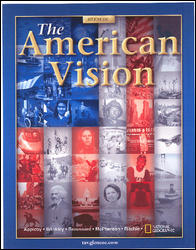

The American VisionChapter 5: Creating a Constitution, 1781–1789Chapter OverviewsThis chapter focuses on how the United States transformed from a young nation loosely structured under the Articles of Confederation to one with a strong federal government under the Constitution. Section 1 discusses why the government created by the Articles of Confederation failed to address many of the pressing needs of the new nation. The Articles of Confederation loosely united the states under the authority of the Confederation Congress. While Congress successfully addressed western settlement and commercial treaties, the problems of a weak central government soon became apparent. Difficulties with foreign powers arose from Congress’s inability to collect taxes, enforce treaties, and regulate trade. Conflicts at home involved interstate trade, a weak currency, and a growing national debt. Concerns over weakening property rights led to civil unrest in Massachusetts. Shays’s Rebellion left four farmers dead and the nation wondering if the Republic was at risk. As citizens deplored the act of lawlessness, many people began to call for a stronger central government. Section 2 describes the issues and debates of the Constitutional Convention. In 1787, 55 delegates from all states except Rhode Island attended the Constitutional Convention to address the weaknesses of the Articles of Confederation. After reviewing new plans for the government, delegates voted to abandon the Articles of Confederation and begin anew. Debates about the new constitution often split delegates geographically and created disputes between small states and large states. A compromise divided state representation into two houses. In the House, representation was based on population, while in the Senate each state had equal representation. Other compromises settled conflicts over slavery. The convention then set to work on deciding how the government would operate. The delegates crafted a constitution that provided for a separation of federal power among the three branches of government—executive, legislative, and judicial—and created a system of checks and balances to prevent any one branch from becoming too powerful. They also included a system to allow amendments to the constitution. Their task complete, 39 delegates signed the new Constitution and waited to see if the states would ratify their document. Section 3 follows the campaign to secure approval of the new Constitution. The Federalists, who supported ratification, led a highly organized campaign that promoted the benefits of a strong central government. Antifederalists opposed ratification because they believed that the Constitution endangered the independence of the states. While several states quickly gave their approval to the new government, other states presented strong opposition. Massachusetts voted for ratification only after Federalists promised to attach a bill of rights to the Constitution. Another concession provided support for an amendment that enhanced states’ powers. By July 1788, 11 states had ratified the Constitution, and the United States launched its new government. The remaining two states ratified the Constitution after the new government was in place. |  |















